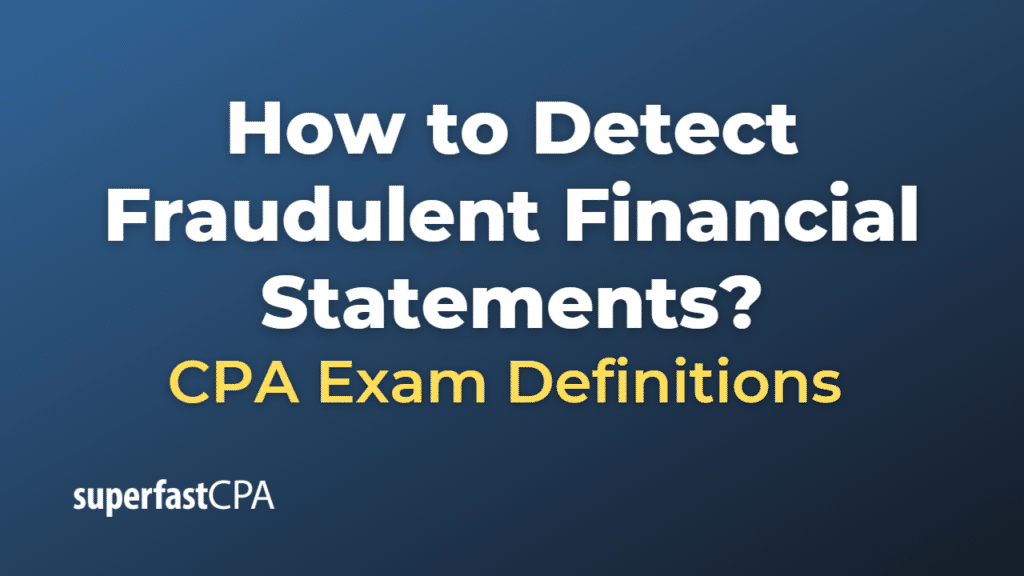How to Detect Fraudulent Financial Statements
Detecting fraudulent financial statements can be a complex task and often requires a solid understanding of accounting principles and financial analysis. However, there are several red flags that can potentially indicate fraudulent activity:
- Inconsistent Financial Trends: Sudden or inconsistent changes in financial trends such as increased revenue but decreased cash flow, or a steady revenue increase despite an industry-wide decline, can signal a problem.
- Unusual or Complex Transactions: Transactions that don’t seem to make business sense, are unnecessarily complex, or frequently occur at year-end might be a sign of fraudulent activity.
- Inflated Assets: Overstated physical assets (inventory, equipment, etc.), intangible assets (copyrights, patents, etc.), or receivables can be a sign of fraud.
- High Number of Off-Balance-Sheet Transactions: While these transactions are not inherently problematic, a large number can indicate an attempt to hide debt or inflate profit.
- Frequent Changes in Auditors or Legal Advisors: This could indicate that the company is trying to prevent these professionals from discovering fraudulent practices.
- Inconsistencies Between Financial Statements and Other Information: Any discrepancies between what the financial statements show and what is reported in tax returns, annual reports, or regulatory filings could be a red flag.
- Excessive Number of Year-End Adjustments: Too many adjustments might mean that the company is ‘window-dressing’ its financial statements to meet expectations.
- Large, Unexplained Transactions or Account Balances: Any large items that don’t come with a satisfactory explanation can be a red flag.
- Significant Transactions With Related Parties: Transactions between the company and its executives, family members of executives, or other businesses owned by the same people should be scrutinized, as they can be a means to move money or assets inappropriately.
- Overly Aggressive Financial Targets: Companies that set unrealistic financial targets can put pressure on employees to commit fraud to meet those targets.
It’s important to note that the presence of one or even a few of these indicators doesn’t necessarily mean fraud is occurring. These are simply red flags that warrant further investigation. If fraud is suspected, a forensic accountant or fraud investigator should be engaged. They use a variety of tools, including ratio analysis, computer-assisted audit techniques, and interviews, to detect fraud.
Example of How to Detect Fraudulent Financial Statements
The fictional company is Crafted Tables Co., a public company that has been experiencing stagnant sales in a thriving market. The company’s financial statements show significant growth in revenue and profits.
Let’s examine some potential red flags that may indicate fraudulent financial statements:
- Inconsistent Financial Trends: Despite stagnant sales, Crafted Tables Co.’s financial statements show a rapid increase in revenue and profit. This inconsistency may suggest that the financial results are being manipulated.
- Inflated Assets: The company’s inventory levels have been significantly increasing over the past couple of years. This might suggest that Crafted Tables Co. is overvaluing its inventory to inflate its assets and overall net worth.
- Discrepancies Between Financial Statements and Other Information : The company’s reported high profits do not align with its tax returns, which show minimal tax liability. This discrepancy could suggest financial statement fraud.
- Unusual Transactions: Crafted Tables Co. has a significant number of year-end transactions, which might be an attempt to inflate the year-end sales figures.
- Significant Transactions With Related Parties: The company has numerous transactions with entities owned by its executives. These transactions are not at market rates, which could be a potential indicator of fraudulent activity.
These red flags alone are not definitive proof of fraud, but they certainly warrant a more thorough examination of Crafted Tables Co.’s financials. A professional investigator or forensic accountant should be brought in to perform this detailed analysis and verify whether fraud is occurring.













